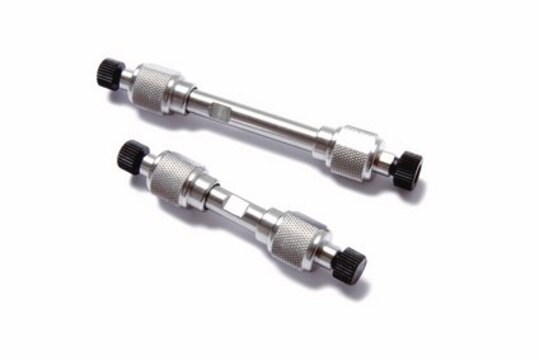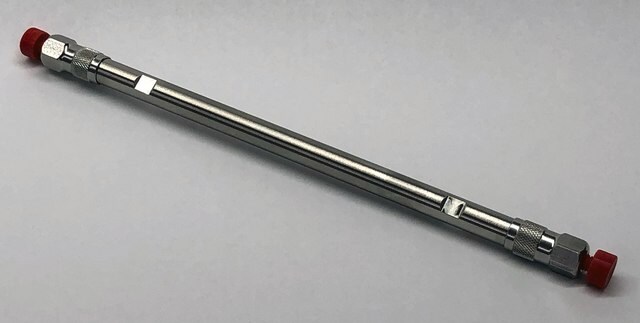567506-U
Discovery® HS F5 HPLC Column
3 μm particle size, L × I.D. 10 cm × 4.6 mm
Sign Into View Organizational & Contract Pricing
All Photos(1)
About This Item
UNSPSC Code:
41115700
eCl@ss:
32110501
NACRES:
SB.52
Recommended Products
material
stainless steel column
Quality Level
Agency
suitable for USP L43
product line
Discovery®
feature
endcapped
manufacturer/tradename
Discovery®
packaging
1 ea of
extent of labeling
12% Carbon loading
parameter
≤70 °C temp. range
400 bar pressure (5801 psi)
technique(s)
HPLC: suitable
LC/MS: suitable
L × I.D.
10 cm × 4.6 mm
surface area
300 m2/g
surface coverage
4 μmol/m2
impurities
<10 ppm metals
matrix
silica gel, high purity, spherical particle platform
fully porous particle
matrix active group
PFP (pentafluorophenyl) phase
particle size
3 μm
pore size
120 Å
operating pH range
2-8
application(s)
food and beverages
separation technique
reversed phase
Looking for similar products? Visit Product Comparison Guide
Related Categories
General description
Guidelines for transferring a C18 method to Discovery® HS F5:
Generally, bases are retained longer on the HS F5 than on a C18. Increasing the organic content of a C18 separation 5 to 10 percent will generally provide similar retention on an HS F5. Results with other compounds are highly variable. However, it is generally true that solutes with log Po/w values less than 2.5 will be retained longer on HS F5 compared to a C18. The degree of difference is highly solute dependent.
Generally, bases are retained longer on the HS F5 than on a C18. Increasing the organic content of a C18 separation 5 to 10 percent will generally provide similar retention on an HS F5. Results with other compounds are highly variable. However, it is generally true that solutes with log Po/w values less than 2.5 will be retained longer on HS F5 compared to a C18. The degree of difference is highly solute dependent.
The Discovery® HS F5 bonded phase provides reversed-phase separations that are distinctly different from C18 columns. However, compounds will generally elute within the same retention time window, making most C18 methods easily transferable.
Features and Benefits
- Unique selectivity
- Similar retention to C18 (sometimes requires stronger mobile phase)
- Excellent peak shape
- Stable, low-bleed LC-MS separations
- Scalable separations from 3 to 10μm particle sizes
Legal Information
Discovery is a registered trademark of Merck KGaA, Darmstadt, Germany
guard cartridge
Product No.
Description
Pricing
Choose from one of the most recent versions:
Already Own This Product?
Find documentation for the products that you have recently purchased in the Document Library.
Federica Pellati et al.
Journal of chromatography. A, 1165(1-2), 58-66 (2007-08-07)
In this study, the chromatographic performance of a pentafluorophenylpropyl (PFPP) stationary phase was evaluated for the rapid separation of phenethylamine alkaloids (i.e. (+/-)-octopamine, (+/-)-synephrine, tyramine, N-methyltyramine and hordenine) in Citrus aurantium plant material (fruits and peel), various Citrus species, extracts
Milan Nobilis et al.
Journal of chromatography. B, Analytical technologies in the biomedical and life sciences, 879(32), 3845-3852 (2011-11-22)
New bioanalytical SPE-HPLC-PDA-FL method for the determination of the neuroleptic drug tiapride and its N-desethyl metabolite was developed, validated and applied to xenobiochemical and pharmacokinetic studies in humans and animals. The sample preparation process involved solid-phase extraction of diluted plasma
Hiroyuki Kataoka et al.
Analytical and bioanalytical chemistry, 405(1), 331-340 (2012-10-16)
We have developed a simple and sensitive method for the simultaneous determination of testosterone (TES), cortisol (CRT), and dehydroepiandrosterone (DHEA) in saliva by automated online in-tube solid-phase microextraction (SPME) coupled with liquid chromatography-tandem mass spectrometry (LC-MS/MS) using a Discovery HS
Federica Pellati et al.
Journal of pharmaceutical and biomedical analysis, 48(2), 254-263 (2007-12-14)
In this study a pentafluorophenylpropyl (PFPP) stationary phase was applied to the fast and reliable qualitative and quantitative analysis of ephedrine alkaloids in Ephedra plant material and derivatives. A Discovery HS F5 column (150mmx4.6mm i.d., 5microm) was used, with an
Ilia Brondz et al.
Journal of pharmaceutical and biomedical analysis, 43(3), 937-944 (2006-11-03)
The drug primaquine diphosphate is used for causative treatment of malaria. Using HPLC-MS and GC-MS, this research group was previously able to show that the main contaminant of primaquine is the positional isomer quinocide [I. Brondz, D. Mantzilas, U. Klein
Our team of scientists has experience in all areas of research including Life Science, Material Science, Chemical Synthesis, Chromatography, Analytical and many others.
Contact Technical Service


![PSS-[2-(3,4-Epoxycyclohexyl)ethyl]-Heptaisobutyl substituted](/deepweb/assets/sigmaaldrich/product/structures/725/762/c5ee3283-bd9d-4deb-87af-d43290ba7a39/640/c5ee3283-bd9d-4deb-87af-d43290ba7a39.png)


